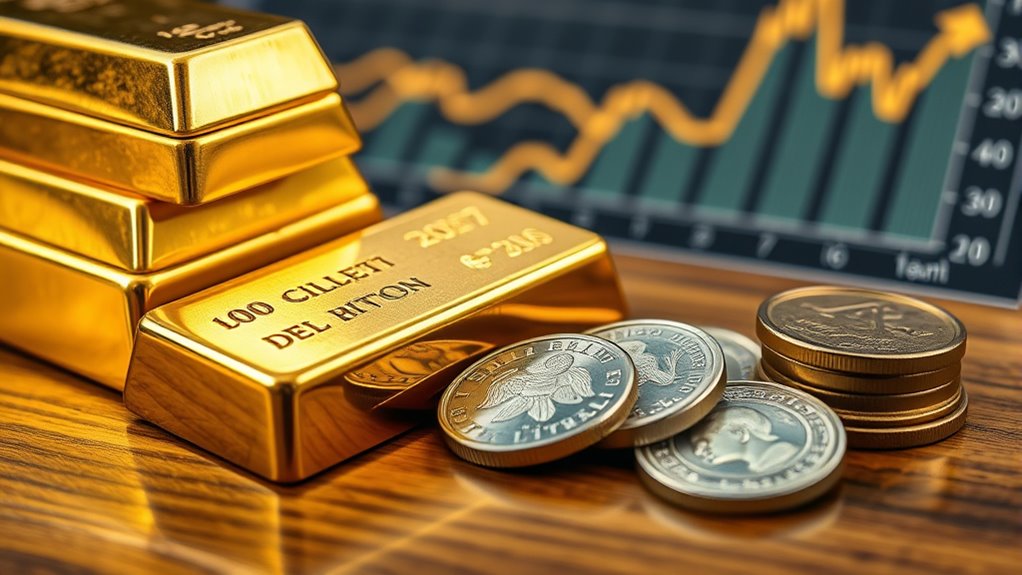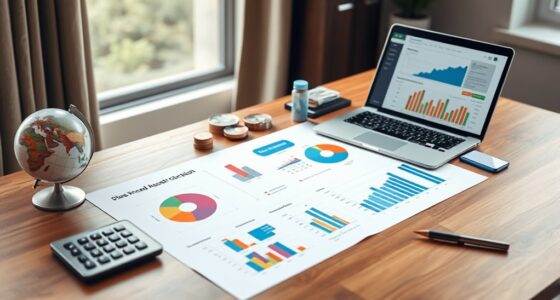Investing in gold and precious metals helps diversify your portfolio and serves as a safe haven during market turmoil. They act as an inflation hedge and retain value when traditional assets underperform. However, they don’t produce income and can be volatile with short-term price swings. Storage and liquidity can also be challenges, especially with physical metals. If you want to understand how to navigate these pros and cons effectively, there’s more to discover.
Key Takeaways
- Diversification and safe haven qualities help protect portfolios during economic downturns and inflation.
- Physical metals require secure storage and may pose liquidity challenges when selling quickly.
- Gold and precious metals do not generate income, relying solely on price appreciation for returns.
- Prices can be volatile, influenced by currency, geopolitical events, and market sentiment.
- Investing through ETFs or digital assets reduces storage issues but introduces counterparty risks.

Investing in gold and precious metals can be a smart way to diversify your portfolio and hedge against economic instability. When markets become volatile, precious metals often act as a safe haven, helping you manage risk and preserve wealth. Because they aren’t directly tied to stock or bond markets, their prices tend to move independently, making them a valuable tool during periods of market volatility. If you’re concerned about inflation eroding your savings, gold and metals like silver or platinum can serve as effective inflation hedges. Historically, these assets tend to maintain or even increase their value when inflation rises, providing a safeguard against the diminishing purchasing power of fiat currencies.
One of the primary advantages of investing in gold and precious metals is their ability to act as a hedge during economic downturns. When traditional investments falter, precious metals often retain their value or rebound quickly. This resilience can help stabilize your overall investment portfolio, especially when other assets are underperforming. Additionally, gold has a long-standing reputation as a store of value, trusted globally for centuries. Its tangible nature provides a sense of security that paper assets can’t always match, especially during times of financial crisis or political unrest.
However, it’s important to recognize the downsides. Precious metals don’t generate income, like dividends from stocks or interest from bonds. This lack of cash flow means they rely solely on price appreciation for returns, which can be unpredictable. While gold can be a reliable inflation hedge, its price can still fluctuate markedly in the short term, driven by factors like currency movements, geopolitical tensions, or shifts in investor sentiment. This volatility can be unsettling if you’re looking for stable, predictable investments, and it’s vital to be prepared for potential dips in value.
Another consideration is liquidity and storage. Physical metals require secure storage, which can incur costs and risks. Selling your holdings quickly might also be complicated by market conditions or premiums/discounts when buying or selling physical assets. Alternatively, investing through exchange-traded funds (ETFs) or digital assets can mitigate some of these issues but may introduce other risks like counterparty exposure. Furthermore, understanding wall organization systems can help you better store and display your physical assets securely at home.
Frequently Asked Questions
How Does Inflation Impact Gold and Precious Metals Investments?
When inflation rises, your gold and precious metals investments often act as an inflation hedge, helping protect your wealth. As currency devaluation occurs, these assets tend to retain or increase their value because they’re not tied to any specific currency. You benefit from this stability, making precious metals a smart option during inflationary periods. They can preserve your purchasing power when traditional currency investments lose value due to inflation.
What Are the Tax Implications of Trading Physical Metals?
Think of trading physical metals as steering a river with hidden currents. You must report your trades for tax purposes, especially through tax reporting, which guarantees you’re compliant. If you sell at a profit, you’ll face capital gains taxes, which vary by your holding period and jurisdiction. Keep detailed records of your purchases and sales to accurately calculate gains and avoid surprises during tax season.
Can Precious Metals Be Used as Collateral for Loans?
Yes, you can use precious metals as collateral for loans through metal-backed loans. Lenders typically perform collateral valuation to determine the worth of your metals, which influences the loan amount you can secure. When you pledge your metals, make sure they are in good condition and properly documented, as this helps streamline the collateral valuation process and increases your chances of obtaining favorable loan terms.
How Do Geopolitical Events Influence Metal Prices?
Geopolitical events notably influence metal prices, causing market volatility and currency fluctuations. When tensions rise or conflicts occur, investors often seek safe-haven assets like gold and precious metals, driving up their prices. Conversely, easing tensions can lead to price drops. You should stay alert to global news, as these events can swiftly impact market stability and metal valuations, affecting your investments or holdings in these assets.
Are There Environmentally Sustainable Options for Investing in Metals?
Like Daedalus seeking a sustainable labyrinth, you can explore eco-friendly options for investing in metals. You should consider eco-friendly mining practices that reduce environmental impact and opt for recycled precious metals, which lower the need for new extraction. These choices help protect the planet while allowing you to invest responsibly. By prioritizing sustainability, you guarantee your investments align with environmental values and promote a greener future.
Conclusion
Investing in gold and precious metals is like planting seeds in a resilient garden—they may not always bloom immediately, but they withstand storms when others falter. While they offer a shining refuge during turbulent times, they aren’t a magic potion for instant wealth. Weigh the risks and rewards carefully; remember, even the brightest treasures require patience and care to truly flourish in your financial landscape.









